Tucked in the small Montsant mountain range, 140 kms South of Barcelona, is a relatively new Spanish wine producing region Priorat- one of the two Spanish DOCa classifications offering excellent unique red wines for 20 years since a renaissance took place, writes Subhash Arora who was wonderstruck by the beauty, uniqueness of the vineyards of this Spanish Gem in the bottle, during a recent visit.
During the two days of tasting organised by Consell Regulador de la Denominació- the Regulatory Council of Priorat a week ago for the first time for a select group of journalists and importers, one could feel the beat and soul of the area while tasting the wines which are unique but powerful and high on alcohol.
At 1888 hA of plantation as on 2010 and 92 wineries, the tiny appellation in Catalonia, compares in vine plantation and number with wineries in Maharashtra and Karnataka. But the similarity ends rather quickly as the quantity of the grapes grown is much smaller. The vines are very old -some as old as 100 years, growing through deep slate known as ‘Llicorella’ and yielding as low as 1 ton/hA and less than a kilo per vine.
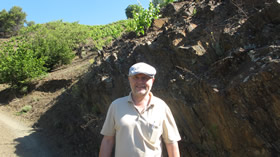 |
| Llicorella-slate in a vineyard in Porrera |
Although La Morera de Montsant is the oldest village in the area, Gratallops is the fastest growing region with 27 wineries followed by Porrera. There are six more villages in the highest Spanish quality appellation Denominació d’Origen Certificada (DOCa) known as Denominació d’Origen Qualificada in Catalonia (DOQ) – Bellmunt, El Loar, Torroja, La Vilella Alta, La Vilella Baixa ( pronounced as Bee-lay-lya Buy-cha), Lower Baixa and Poboleda. Each of the village has a population of less than 600 and mules are still used to plough some of the terraced, steep slopes.
Falset is the most important town, the capital of the region having around 2000 inhabitants. The northern part of the village as also the eastern part of another small village El Molar, also form a part of the appellation DOQ Priorat or DOCa- Priorato (this is the rough equivalent of Italian DOCG and perhaps higher as the DOCG wines of late have been getting diluted very fast)
The region boasts of over 700- year wine history as the Carthusian monks from France arrived here in the mid 12th century and started making wine in 1194. Although the region was recognised as early as 1932 when the work on classification started in Spain-the appellation system was postponed due to the Spanish Civil War and was finally put into action in 1954 when Priorat was given a DO status (Denominació d’Origen) – roughly equivalent of Italian DOC and the French AOC.
But the wines were and remained of poor quality and made in bulk for drinking as a substitute for water and did not have much marketing potential. The area remained poor and several people left for greener posture, bringing down the vine cultivation to considerably lower than the 5000 hA a century ago.
The credit for Renaissance goes to a local wine professional René Barbier, a fourth generation wine maker from the nearby Tarragona (an exclusive interview with him follows in a subsequent issue of delWine) who recognised the huge potential of the soil and climate and bought land in the 70s when he was working as an export manager for a winery Palacios Remondo in Rioja.
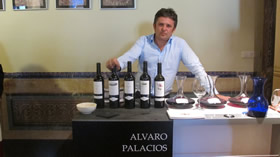 |
| Wines at a Tasting with Alvaro Palacios |
He convinced 4 other appassionatos to come to the area and together in 1989 they started making wine together with his Clos Magador, iconic Álvaro Palacios, Clos Mas Martinet owned by a local Prof Josep Perez who has earlier established a college for enology and viticulture in Falset, Clos Erasmus and Clos de L’Obac.
Scala Dei and Masia Barril were two wineries bottling fairly decent wines earlier; the latter was bought over by Mas d’en Gil in the mid nineties Soon after, quality producers like Cellar Vall Lach founded by the well known Spanish folk singer and songwriter Lluis Llach, came on the scene. Ferrer Bobet here were quite a few that including Gratavinum, La Conreria d’Scala, La Perla del Priorat produce good quality wines and would like to sell in India.
Christopher Canaan - president of Bordeaux-based Europvin, an importing company and wine merchants which exports to India through Brindco, also bought Clos Figueras in Gratallops with his wife Charlotte from Bordeaux, Miguel Torres with his Torres Empire in close-by Villa Franca also entered the region with Torres Priorat; his daughter Mireia is looking after this winery.
Palacio Remondo in Rioja is a very well known winery in Rioja where Barbier had been working as the export manager. Alvaro had worked with him for some time in the winery for selling the wines. When Rene came to Gratallops and decided to start vinification in Priorat, he convinced Palacios to join forces despite a stiff opposition from the latter’s family. Bordeaux trained Alvaro was keen to make some Spanish wine which would compete with the Grand Crus of Bordeaux. When he visited the area, he was duly impressed with the slate and poor soil that would be perfect for making high quality wines. Unknown to most, his family was very unhappy about his decision to go to an unknown region known for its poor wines and practically disowned him but today they welcome his decision and he is the one who calls the shots at both the wineries.
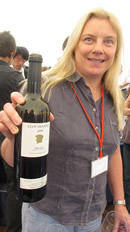 |
| Dephne Glorian with Clos Erasmus |
Dephne Glorian, the French-born Swiss lawyer who graduated from the University of Paris and later married Eric Solomon in 1997, a powerful wine importer with strong journalistic connections, has already attained the status as a cult wine producer with her limited quantities of Clos Erasmus in the US. When I met her and tasted with her at a Tasting in Scala Dei monastery, she told me that her wines have no fixed price in the market as many people bought only to resell at high profits, sometimes many times over. Her wines rated very highly by Robert Parker consistently, she has already reached the cult status though as she says with a distinct twinkle in her eyes, ‘you are saying it-I am not.’
Alvaro has is become a face of Priorat because of his passion for the region and the quality of wines – his L’Ermita is iconic and one of the most expensive Spanish wines.
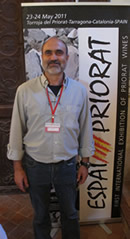 |
| Salus Álvarez, President of the DOQ Priorat Council |
Salus Álvarez, President of the Council for over six years and also the General Manager of Cellar Val Llach says in an exclusive interview with delWine, ‘we are a small region with several new and small producers who do not find it feasible to travel overseas frequently. So we decided to get journalists like you and importers who can present the uniqueness of our region.’ Salus who has also been a mayor of his village Porrera adds, ‘we say that in our region, the beautiful vineyards which are difficult and costly to work with may not be the best in the world but we are unique, especially because of our soil. You may love or hate our wines and the region but you cannot be indifferent.’
Robert Parker has been a great fan of the region and has predicted that it will overtake Rioja in a few years. This may not be possible as a region; at 1888 hA it is much smaller than Rioja which has around 150,000 hA of potential vine land. But undoubtedly, some of its wines are capable of beating Rioja wines in the international arena on prices and preferences due to the unique character.
Whereas Rioja wines are based on Tempranillo and Grenache, Priorat has Carignan and Grenache as the main grape varietals (over 60% of total production)- both performing well as warm weather grapes- a fact that ought to be of interest to the Indian producers, provided the day-night temperature difference is 20◦ C or more. In Priorat, sometimes it gets to be as high as 25◦ C.
Red Wine Country
Unfortunately, Priorat is a red wine country with less than 5%- hardly 100 hA have white grapes like Grenache Blanc, Macabeo and Viognier as cultivation. Efforts are being made to bring out some more whites- Clos Magador and Clos Figueras were a couple of outstanding white wines tasting. But as Rene Barbier 5 (Rene’s son working with him) says, ‘in our efforts to find out how we can produce better white wines, we have discovered some local grapes who we believe from experience will make very good wine.’ Disagreeing with my impression that Viognier seems to have done well on the palate, he says, ‘there is no doubt that there will be some increase in white wine production but we shall go with the newer local varieties.
Currently Grenache is the most popular grape with 37% plantation that includes other forms of Grenache as well-Grenache Pais and Grenache Peluda. Shiraz is next in line at 13% share but the focus has been on reducing this number and increase production of the main grape varietals. Carignan works better in more heat although Grenache also grows well in hot weather. White Grenache, Moscatell, Picapol Blanc and Viognier work the best.
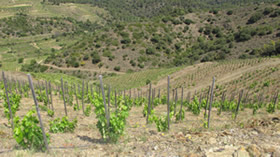 |
| A steep vineyard near Gratallops |
Gratallops has become the hub of Priorat wine producing areas with the majors and the followers numbering 27 already being present and several new wave wineries having come up after the Famous Five dug their heels into town,. Porrera and Bellmunt having around 8 wineries in each village are also popular locations.
Unfortunately, wines from Priorat have not been able to wet their feet yet in India but there is a huge potential for them in the restaurants and once the connoisseurs discover the minerality and unique taste of these wines due to the unique soil of the region and an interesting mix of grapes which are not found anywhere else in the world- generally speaking.
Subhash Arora
Wine Tasting and Winery Visits will be published in the future issues-editor
|